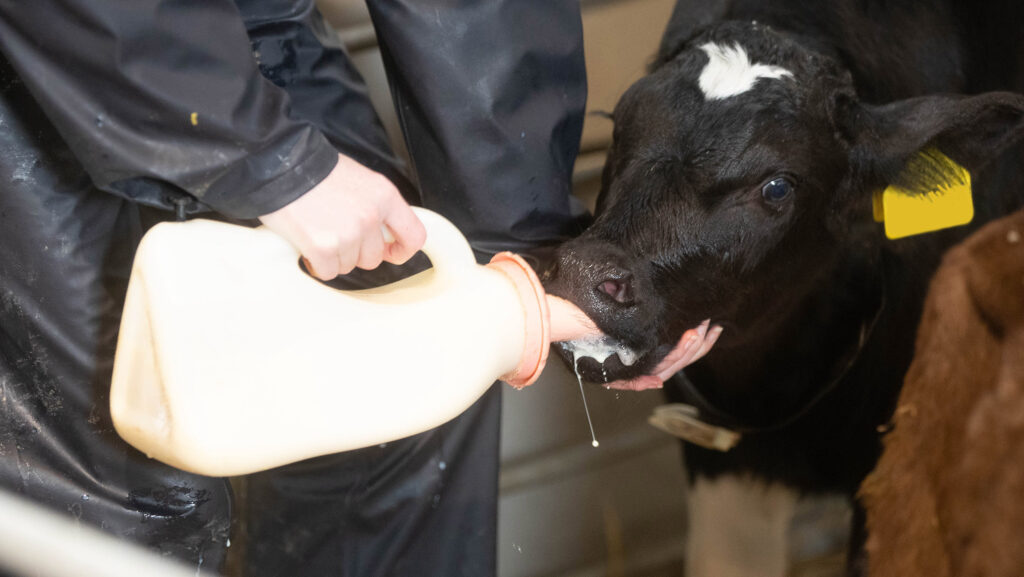New colostrum booster to tackle calf scours gets import licence
 © Tim Scrivener
© Tim Scrivener Early adopters of a colostrum-boosting vaccine being imported from the EU are integrating it into youngstock plans via a five-step knowledge exchange protocol.
Farmers have worked with vets to obtain special licences to import Bovilis Cryptium from Ireland, to help tackle cryptosporidium parvum (C parvum), a leading cause of calf scours.
Manufacturer MSD Animal Health has confirmed that its C parvum vaccine was approved for UK use by the Veterinary Medicines Directorate (VMD) in August, but says farmers will have to wait until November to source the product locally.
See also: 7 ways to prevent colostrum contamination
Vet-led product
Bovilis Cryptium must be prescribed and supplied by a vet.
Pregnant heifers and cows given the vaccine in the third trimester of pregnancy are stimulated to produce antibodies against the protein Gp40 of C parvum.
These antibodies (immunoglobulins or IgGs) are present in the colostrum when ingested by the calf, allowing it to develop passive immunity to C parvum.
Dr Katie Denholm, from Glasgow Veterinary School, says colostrum contains a host of beneficial immune modulators.
“Oligosaccharides, valuable enzymes, lactoferrin, cytokines, hormones, vitamins and minerals – all are important for long-term gut health, function and development,” she says.
To get the best use out of the vaccine, MSD has produced a questionnaire for farmers to complete with their vet.
“Working through a series of five key questions within each of these five basic steps allows both parties to quickly pinpoint any areas needing attention,” says Kat Baxter-Smith, a veterinary adviser at MSD Animal Health.
Five-step plan
MSD has developed the following plan to assist farmers with cryptosporidiosis management and maximising the benefit of colostrum:
1. Diagnose
- Scours can be caused by multiple pathogens – an accurate diagnosis will help address the problem and treat calves
- Cryptosporidium can be identified through faecal sampling with your vet
- Salmonella cultures and coccidiosis counts can rule out other causes
2. Achieve the five Qs of colostrum
- Quality >50g/litre immunoglobulins (IgG) in colostrum
- Quickly Within the first six hours of life
- Quantity 10-12% of the calf’s bodyweight in colostrum. This will typically deliver 15-200g of IgG. Calves should be fed entirely from dam for the first five days, or receive at least three litres of day-one colostrum
- Quietly Feeding calves gently without force will help the animal drink and absorb the colostrum and its IgGs. This is particularly important when tube feeding
- Quantify Measure blood serum in the calf. It should have >10g/litre of IgG in serum. Colostrum should have >50g/litre of IgG in colostrum
3. Environment and management
- Disinfection and boot dips on entrances to calf facilities
- Identify and isolate sick calves and keep them warm and hydrated (it is dehydration that kills them)
- Work with healthy calves first before sick ones to minimise disease spread
- Never mix newborn calves with calves older than three to four days
- Wash and disinfect feeding equipment daily
- Replace/replenish bedding every one or two days
- Ensure calves don’t defecate in troughs – position them at least 75cm off the floor
4. Prevention
MSD says vaccinating pregnant heifers and cows with Bovilis cryptium can protect calves during the vulnerable early days of life, reducing clinical signs of C parvum (diarrhoea).
5. Treatment
- Products with halofuginone lactate can help clear up diarrhoea caused by C parvum because it is a salt with antiprotozoal properties. It is licensed for prevention and treatment
- Hydration with oral electrolyte solutions is often recommended to address dehydration.
